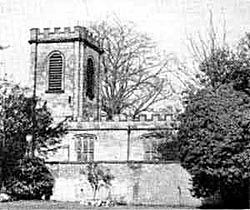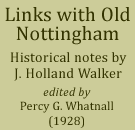< Previous | Contents | Next >
Colwick church
 |
COLWICK CHURCH stands in a somewhat inaccessible situation and at first sight it is perhaps a little dreary and not particularly interesting from an architectural point of view, but it has, nevertheless, a great deal of interest, and it enshrines a number of extremely interesting tombs and monuments.
All traces of the ancient church of Colwick have disappeared, for the present church was built by Sir John Byron, of Colwick, who, in 1540, acquired the site of the Priory of Newstead. It is hard to understand why he should have rebuilt Colwick Church during the troubled times immediately succeeding the dissolution of the monasteries, and harder still to understand how he came to establish a chantry in his new church some years after chantries had been abolished. But he did both these things, and Colwick Church must be one of the very few churches built in the country at a time when interest in ecclesiastical matters was not only unfashionable but positively dangerous.
The Byrons left Colwick in 1643 and settled at Newstead, and soon after this date the Musters came to Colwick. In order to celebrate the Restoration of Charles II. to the throne of his forefathers, Sir John Musters, in the year 1661, removed the panelling from the dining-room of the Hall, and set it up in the Church, using it as a dado. This dado consists of thirty or more panels carved in low relief with scrolls and masks, and are both beautiful and interesting.
The east window is filled with glass painted by Mrs. Sophia Musters some century or so ago, and she copied as her design the celebrated windows in the Chapel of New College, Oxford, which were designed by Sir Joshua Reynolds.
The gateway in the churchyard is an excellent example of Nottingham wrought ironwork. It is contemporary with the Hall, that is to say it was made about 1776. A second gate is preserved in Nottingham Castle, and about it an interesting tale is told. When the rioters wrecked the Hall in 1831 they appear to have thrown this gateway into the lake, where it lay rusting and forgotten for many years. It was recovered accidentally, and set up when the churchyard was enlarged at the end of last century.
